All trekking in Nepal begins with a bus ride, and all bus rides in Nepal are an adventure in themselves. My trip to Langtang national park was no exception, clocking in at just over 12 hours of jostling and lurching. There were an average of 8 people per row on the little 12 row bus, one live chicken in the overhead bin, and 20 or so folks on the roof . That puts our total at around 110 people, all bumping along that narrow road carved from the mountain side. A single chicken hardly provides the level of species diversity that you expect on busses in Asia, but the she made herself well known over the rougher parts of the road. At one of the highest and narrowest points, the road was blocked by a stalled truck coming the other direction. After a few hours another large truck lumbered down the hill and was quickly called into service to tow the stalled one backward just enough for the driver to execute a perfect reverse-clutch start. It was another hour for all the backed up traffic to slide passed each other and we were on our way.
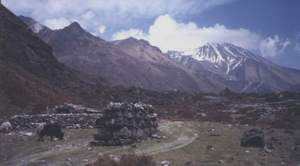
First peek at the Langtang valley Chergo-Ri has its summit in the clouds. The wall ahead is built of stones engraved with Sanskrit prayers in an ornate script.
On the bus I met Tamar from Israel and Lupe from Mexico and we formed one very international gang of trekkers. We took our time up the lush valley, climbing from 1400 meters to 3300 meters over the next few days. We passed a large heard of sheep, accidentally walked through some marijuana fields, heard some monkeys, and saw some incredible rhodedendrum flowers. At the town of Thangsyapu, the girls went ahead and I hung back to acclimatize and spend a day playing my guitar in the mountains' shadow.
The next day I headed up to Changkang Gompa, the furthest permanent settlement in the Langtang Valley and a perfectly situated between the impressive Ganga La pass on one side and the Langtang mountain and Glacier behind. After another rest day, I made plans to climb the small peak of Chergo Ri, a modest 5100 meter peak.
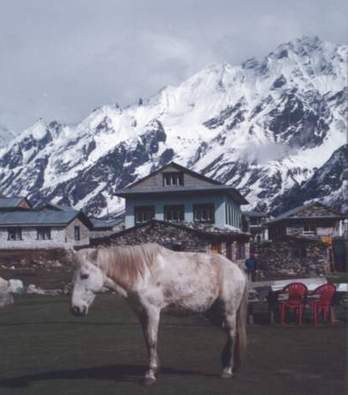
High-altitude Horsey This pony lives at 4000m. Horses are a common means of transportation in hills, especially when you neet to get somewhere fast.
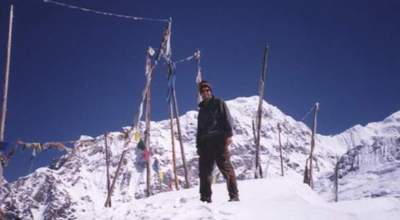
Chergo-Ri Standing on the summit, 5100m. Langtang peak looks down on me from behind.
When I was 10 years old, I and my cousins went to the Great Sand Dunes in southern Colorado. On our last day, we decided to climb the very biggest sand dune which towered over our campsite. After a few hours of hiking in the hot sand we reached the top where a great surprise awaited us: Behind the dunes we could see from camp lay a huge sea of dunes that reached almost to the horizon.
Summitting Chergo Ri brought on a wave of Deja Vu. From the top you could see mountain peaks in every direction, stretching as far as I could see and all of them massive beyond imagination. It still felt good to summit my little mountain, but the true scope of the Himalayas is humbling.
Later that night as I looked up at the sea of stars I recalled an interesting fact I'd once read: If you pick up a handful of sand at the beach you'll have about 5000 grains in your hand--about the same as the number of stars you can see on a perfectly clear night. But the total number of stars in the universe is actually greater than the grains of sand on all the beaches of planet Earth.
On the way down from Langtang I met some wildlife, and a Nepali graduate student studying English literature in Kathmandu. He flipped through the pile of songs I was carrying and randomly hit upon "Bizzare Love Triangle." He then proceded to give a half-hour literary analysis of the author's message and underlying themes. Something about a botched romance, about a catch-22 for the broken-hearted singer, about falling upwards to heaven, and about love as a metaphor for god. No doubt about it, he's ready for academia!
From the Langtang valley, you can skip the return bus journey and literally walk back to Kathmandu by travelling over the Gosaikund pass. Gosaikund means "Shiva's Lake," so named because the pass and its many Lakes are thought to be the home of Shiva. (He went there to drink the cool water after drinking a potion so spicy that it would kill any lesser god.) So for Hindus, a trip to Gosaikund is a trip to heaven. As I soon learned, it can be quite divine for others as well.

Trekking Buddies These small ones hiked with me for the 1000 meter ascent to Thula Syaphru, where we stopped for a drink and some songs at the old man's shop.
The hilite of that leg of the trip was the arduous hike from Bamboo up to Thula Syaphru. I passed a woman picking leaves for her cow (who munched nearby) and she asked where I was going. Hearing Thula Syaphru, she communicated with gesturs and broken english that her two children were going there as well and would walk with me. Angeli and Thong-sa are just about the cutest kids you could imagine, probably around 5 and 9 years old, The girl, Angeli, was the youngest but hiked in front and set a grueling pace. But whenever I would stop in exhaustion they would smile and sit next to me until I was ready to move on. At the apex of the hill I needed a big break and pulled out my guitar, which they had been eyeing curiously the entire time. So I sang them a few songs and they coaxed me to sing a few more. I tell you, no rock star has ever had a better, more appreciative, more awe-struck audience. My body has slowly forgotten the pain of that hike, but it will be a long time before I forget their smiling faces!
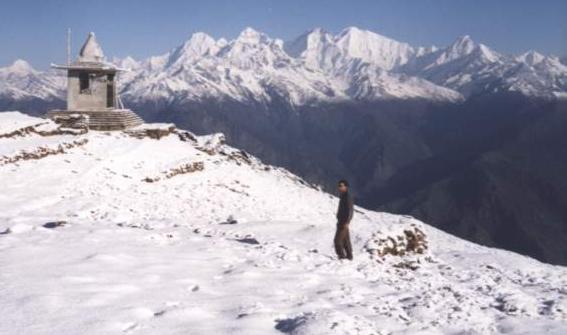
Almost to Gosaikund Looking west to the Annapurna
range in the distance. I'm at 4000m, the valley between is at 1000m, and the mountains in the distance are 8000m.
The scale of Nepal is breathtaking!
From there it was a gradual progression up to the lakes, with the weather getting cooler and the
trail getting harder to find. I lost my way at one point and ended up climbing to a town
500 meters above the one I was aiming for.
It rained, hailed, and snowed the day before I went over the pass, which left everything
shimmering white and astoundingly beautiful.
My guesthouse owner's son and I passed the rainy day strumming on my guitar. He picked it up quick and by the end of the day was doing the G-C-D thing pretty well. That night we stuck a trade: The guitar in exchange for a shawl, a scarf, a traditional handbag, two bags of muesli, and a cup of hot chocolate. Apparently his mom didn't know about the muesli part of the deal: he arranged a secret meeting up the trail at 5am the next morning where we would close the deal! (When you get this high in the hills, both guitars and muslie are rare and coveted!)
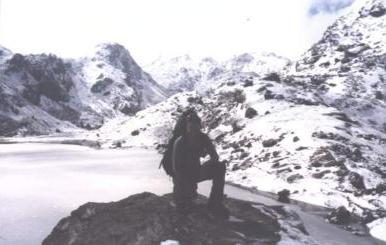 Overlooking one of Shiva's Lakes The water was clear, but a tad chilly for swimming. |
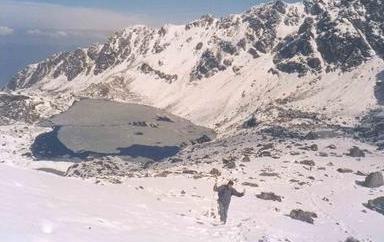 Crossing the Pass Okay, okay. That's really Dinesh, not me. But it's a great photo. Can you believe the land at the horizon is all the way in India? |
After my 5am start, I passed over pass in perfect solitude, surrounded by icy lakes and snow-capped rock spires. But my awe was soon interrupted by a dark and menacing cloud moving towards me. That got my butt in gear and I pranced down the desolate rock field on the other side of pass, finding just enough of the trail to keep going and hoping to get below the cloud before it engulfed me!

Doing your business Here's a typical restroom facility at a guesthouse. I know you were wondering!
What a relief then when I ran into Dinesh and Anu a few hours later. Dinesh is a Nepali newspaper reporter, Anu is from the Netherlands but works for a tourism company in Kathmandu. We ended up hiking together for the remainder of the trek. The next few days were filled with rain and we passed the time playing cards and discussing Nepali and American politics.
I had to hurry to catch the last flight on Bangledesh airlines before my visa expired, so the last few days were harried and hectic. After all those days in the chilly hills, it was quite a shock to arrive to 40 degree weather (103F) in Bangkok! I mailed all the cold weather gear home and am now sweating it out in Chiang Mai. What's next? Cambodia? A beach? Who knows!